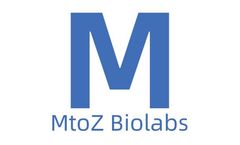Diabetes Study Seeing Diabetes Articles & Analysis
191 articles found
Chitosan is a natural, biodegradable polysaccharide derived primarily from the shells of shrimp, crabs, and fungi. Due to its biocompatibility, antimicrobial properties, and film-forming capabilities, chitosan is widely used in food preservation, water treatment, cosmetics, agriculture, and biomedical applications. 1. What is Chitosan? Chitosan is produced by the deacetylation of chitin, a ...
ByMatexcel
Introduction The BALB/C mouse is a widely used inbred strain in biomedical research, particularly in the fields of immunology, cancer research, and genetics. Among the various tissues studied, the kidney holds significant importance due to its complex structure and multifaceted role in physiological functions. A formalin-fixed paraffin-embedded (FFPE) block of the BALB/C mouse kidney serves as an ...
Matrix Gla Protein (MGP) is a small, vitamin K-dependent extracellular matrix protein that plays a critical role in the regulation of vascular calcification and bone development. As a natural inhibitor of pathological mineralization, MGP has attracted significant attention in cardiovascular and skeletal biology research. The development of recombinant MGP protein has enabled researchers to study ...
Immortalized human podocytes represent a significant advancement in the field of renal research, offering scientists an unprecedented opportunity to study kidney function and pathology. These specialized cells play a crucial role in the filtration barrier of the kidneys, and their immortality allows for extended experimentation beyond the limitations of primary cell cultures. Podocytes are unique ...
Weight and sleep interconnected and that fact is oftentimes overlooked. If you are having issues sleeping or wake up frequently at night, did you gain weight recently? If you have, you are not alone. Many studies have shown that weight gain does lead to poor sleep and can impact REM sleep, due to hormonal imbalances and sleep disorders, such as sleep ...
A sleep disorder, sleep apnea is characterized by repeated breathing pauses during sleep. The hypopnea and apnea episodes can last from a few seconds to a minute at a time and can occur many times during a night. Obstructive Sleep apnea happens when the throat muscles relax and the tongue falls back into the throat, partially blocking the airway. That in turn leads to improper breathing as the ...
Podocytes are specialized epithelial cells located in the kidneys, playing a crucial role in the filtration barrier of the glomerulus. These unique cells have garnered significant attention in scientific research due to their pivotal function in maintaining kidney health and their involvement in various kidney diseases. The Structure and Function of Podocytes Podocytes possess a distinct ...
Anti-Tumor APIs: Pioneering Cancer Treatment Anti-tumor Active Pharmaceutical Ingredients (APIs) are vital in today's medical landscape, addressing one of the most pressing health challenges: cancer. These APIs form the foundation of various therapeutic strategies aimed at inhibiting or destroying tumor cells in the human body. The classification of anti-tumor APIs often falls into four main ...
In the fast-evolving landscape of biotechnology and systems biology, understanding the dynamic processes that sustain life at a cellular level is crucial for advancing research and therapeutic applications. One essential approach to studying cellular metabolism is Metabolic Flux Analysis (MFA), a powerful tool that reveals the intracellular activities and metabolic dynamics of living systems. ...
Nuclear receptors are a class of proteins that play a vital role in cellular communication, gene expression, and overall homeostasis within the body. They act as transcription factors, responding to various stimuli, including hormones, nutrients, and even environmental agents. Due to their crucial roles in physiological and pathological processes, nuclear receptors have emerged as significant ...
Introduction Microarray printing technology has revolutionized the field of genomics and proteomics, and its application in glycobiology is no exception. Glycobiology, the study of carbohydrates and their biological functions, relies heavily on the ability to analyze large-scale carbohydrate interactions. Microarray printing in glycobiology enables the precise and high-throughput analysis of ...
Skeletal muscle microvascular endothelial cells (SMECs) play an essential role in maintaining muscle function, metabolism, and overall health. These specialized cells line the blood vessels within skeletal muscles, forming a barrier that regulates the exchange of substances between the bloodstream and muscle tissue. Their significance extends beyond mere structural support; they actively ...
Human corneal epithelial cells play a vital role in maintaining the health and function of the cornea, the transparent front part of the eye. This layer of cells acts as a protective barrier against environmental insults, pathogens, and mechanical injury. Given their crucial functions, understanding these cells is essential for advancements in ophthalmology and regenerative medicine. The corneal ...
Secretory proteins refer to those proteins that are synthesized by cells and secreted to the outside of the cell. They play an important role in many biological processes such as signal transduction, cell communication, immune response, hormone secretion, and so on. These proteins are usually synthesized in the endoplasmic reticulum (ER) of the cell and then transported out of the cell through a ...
Glycosylation site detection refers to identifying the location where glycosylation occurs in biomolecules. Glycosylation is a biochemical modification process that involves linking sugar molecules to other biomolecules (such as proteins, nucleic acids, or lipids), thereby affecting their structure and function. Glycosylation plays a critical role in organisms, but it may also be associated with ...
Collagen is the most abundant protein in tissues and organs, and glycated collagen refers to collagen modified by glycosylation. Glycated collagen mainly exists in various tissues in the human body, especially those rich in collagen, such as skin, bones, joints, blood vessels, and other connective tissues.Under normal physiological conditions, glycation occurs as a natural biochemical process, ...
In biomedical research, the detection and analysis of biomarkers are crucial. Among them, glycoproteins are an essential biomarker that plays a key role in many biological processes, including disease onset, progression, and treatment response. The Tandem Affinity Purification (TAP) of glycoprotein is an efficient detection method.What Is a Glycoprotein?Firstly, let's understand what a ...
Furthermore, changes in the mitochondrial proteome may be associated with certain diseases, including neurodegenerative diseases, cancer, heart disease, diabetes, and genetic disorders.Methods of Mitochondrial Protein SequencingMitochondrial protein sequencing typically involves the following steps: firstly, scientists need to extract the mitochondria from cells and isolate the ...
Biopharmaceuticals and personalized medicine are hot fields in the development of the pharmaceutical industry today. Proteins, peptides, and antibodies are important molecules in the body and are important objects of research in biopharmaceuticals and personalized medicine. With the continuous advancement of protein, peptide, and antibody sequencing technology, they are playing an increasingly ...
Sugar nucleotides are key molecules in the biosynthesis of glycans, which are carbohydrate chains found on the surface of cells or in the bloodstream. These molecules play a critical role in a wide range of biological processes, including cell signaling, protein folding, and immune responses. In this article, we will delve into the structure and synthesis of sugar nucleotides, and explore their ...














